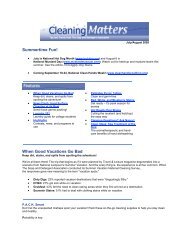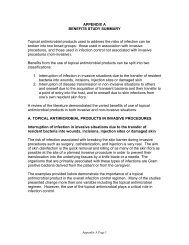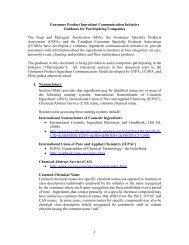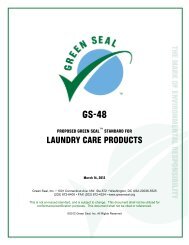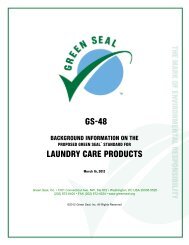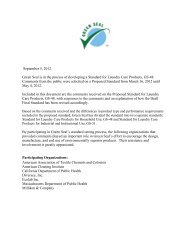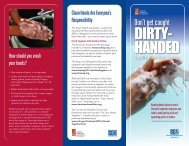subchapter c -- federal hazardous substances act regulations
subchapter c -- federal hazardous substances act regulations
subchapter c -- federal hazardous substances act regulations
Create successful ePaper yourself
Turn your PDF publications into a flip-book with our unique Google optimized e-Paper software.
16 CFR Ch. II (1–1–05 Edition) – proposed modification – 6/25/06<br />
(2) Test equipment — (i) Loading device.<br />
The loading device shall be a torque gauge,<br />
torque wrench, or other appropriate device<br />
having an accuracy of ±0.2 inch-pound (±0.23<br />
kilogram-centimeter).<br />
(ii) Clamp. The clamp shall be capable of<br />
holding the test component firmly and<br />
transmitting a torsional force.<br />
(3) Testing procedure. With the toy rigidly<br />
fastened in any reasonable test position, the<br />
clamp is fastened to the test object or<br />
component. A torque of 3 inch-pounds ±0.2<br />
inch-pound (3.46 kilogram- centimeters) shall<br />
be applied evenly within a period of 5 seconds<br />
in a clockwise direction until a rotation of 180<br />
degrees from the original position has been<br />
attained or 3 inch-pounds ±0.2 inch-pound<br />
(3.46 kilogram-centimeters) exceeded. The<br />
torque or maximum rotation shall be<br />
maintained for an additional 10 seconds. The<br />
torque shall then be removed and the test<br />
component permitted to return to a relaxed<br />
condition. This procedure shall then be<br />
repeated in a counterclockwise direction.<br />
(f) Tension test — (1) Application — (i)<br />
General. Any projection of a toy that the child<br />
can grasp with at least the thumb and<br />
forefinger or the teeth shall be subject to this<br />
test. This test is to be conducted on the same<br />
toy that has been subjected to the torque test<br />
described in paragraph (e) of this section.<br />
(ii) Stuffed toys and beanbags. A stuffed<br />
toy or beanbag constructed of pliable materials<br />
having seams (such as fabrics) shall have the<br />
seams subjected to 15 pounds ±0.5 pound<br />
(6.80 kilograms) of force applied in any<br />
direction.<br />
(2) Test equipment — (i) Clamps. One<br />
clamp capable of applying a tension load to<br />
the test component is required. A second<br />
clamp suitable for applying a tension load<br />
perpendicularly to the major axis of the test<br />
component is also required.<br />
(ii) Loading device. The loading device is<br />
to be a self-indicating gauge or other<br />
appropriate means having an accuracy of ±0.5<br />
pound (±255 grams).<br />
(3) Testing procedure. With the test sample<br />
fastened in a convenient position, an<br />
appropriate clamp shall be attached to the test<br />
object or component. A 15-pound ±0.5 pound<br />
(6.80-kilogram) direct force shall be evenly<br />
applied, within a period of 5 seconds, parallel<br />
to the major axis of the test component and<br />
-- 62 --<br />
maintained for an additional 10 seconds. The<br />
tension clamp shall then be removed and a<br />
second clamp appropriate for pulling at 90<br />
degrees shall be attached to the test object or<br />
component. A 15-pound ±0.5 pound (6.80-<br />
kilogram) tensile force shall be evenly applied,<br />
within a period of 5 seconds, perpendicularly<br />
to the major axis of the test component and<br />
maintained for an additional 10 seconds.<br />
(g) Compression test — (1) Application.<br />
Any area on the surface of a toy that is<br />
accessible to a child and inaccessible to flatsurface<br />
cont<strong>act</strong> during the imp<strong>act</strong> test shall be<br />
subject to this test.<br />
(2) Test apparatus. The loading device<br />
shall be a rigid metal disc 1.125 inches ±0.015<br />
inch (2.86 centimeters) in diameter and 0.375<br />
inch (0.95 centimeter) in thickness. The<br />
perimeter of the disc shall be rounded to a<br />
radius of<br />
1 ⁄ 32 inch (0.08 centimeter) to<br />
eliminate irregular edges. The disc shall be<br />
attached to an appropriate compression scale<br />
having an accurancy of ±0.5 pound (±225<br />
grams).<br />
(3) Testing procedure. The disc shall be<br />
positioned so that the cont<strong>act</strong> surface is<br />
parallel to the surface under test. A direct force<br />
of 25 pounds ±0.5 pound (11.4 kilograms)<br />
shall be evenly applied within 5 seconds<br />
through the disc. This load shall be maintained<br />
for an additional 10 seconds. During the test<br />
the toy is to rest on a flat, hard surface in any<br />
convenient position.<br />
§ 1500.53 Test methods for simulating use<br />
and abuse of toys and other articles<br />
intended for use by children over 36 but not<br />
over 96 months of age.<br />
(a) Application. The test methods<br />
described in this section shall be used to<br />
simulate the normal and reasonably<br />
foreseeable use, damage, or abuse of toys and<br />
other articles intended for use by children over<br />
36 but not over 96 months of age in<br />
conjunction with § 1500.18.<br />
(b) Imp<strong>act</strong> test — (1) Application. Except<br />
as provided in paragraph (b)(4) of this section,<br />
toys having a weight of less than 10.0 pounds<br />
±0.01 pound (4.6 kilograms) shall be subject<br />
to this test.<br />
(2) Imp<strong>act</strong> medium. The imp<strong>act</strong> medium<br />
shall consist of a 1 ⁄ 8 -inch (0.3-centimeter)<br />
nominal thickness of type IV vinylcomposition<br />
tile, composition 1 — asbestos



